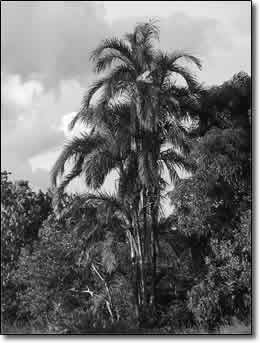
Hearts of the Amazon
by Chef Boy Ari

Riding the riverboats around the Amazon (the jungle, not the river) is a good way to comprehend the region's - and the river's - enormity. You ride for days and cover pitiable distances. Sometimes you can't even see the shore. Sometimes you skirt islands bigger than Switzerland.
My first time in this hungry jungle, almost half a lifetime ago, I was walking through the lowlands of Bolivia with a man named Chimo. He had just shot some grouse-like birds, and we were headed back to camp to cook them. Chimo stopped in front of a small palm tree, dropped the birds and hacked down the palm with his machete. He then used his machete to remove concentric layers of tree tissue from the long, straight section of trunk, until all that remained was the thin core of the tree, about the diameter of a quarter. This was the heart of palm, and we devoured it by the foot. It was tender, delicate, subtle and completely delicious.
Years later, I took a boat across the big brown mouth of the Amazon, a journey of three days. We stopped at a small town on the shore of an island along the way, and there was a stack of crates on the dock waiting to be loaded on our boat. Next to the crates, men with machetes were dismantling those same palm trees and loading the cores into the crates. I thought of all the crates that were loaded up every day in all the innumerable small river towns scattered throughout the Amazon - millions of trees destroyed for their thin, naked hearts. From then on, eating palm hearts did not come without guilt.
But nowadays there's a new culinary rage in Brazil that represents common ground between the taste buds and the conscience. It's a red syrup made from the fruits of that same palm tree. It's called Ašai (ah-sigh-ee).
From the urban jungles of Rio and Sao Paulo up the long Brazilian coast and across the vast interior of the country, Ašai has quickly become wildly popular in Brazil. Stores and cafes display its availability with special signs. Boosters, backed by a growing body of research, praise its energy-giving qualities, its omega-3 fatty acids, its diverse amino acid profile, its rich array of antioxidant and its creamy, fruity flavor. I've drank Ašai by the cup in Rio, in bowls with granola in Salvador, and poured it unsweetened on fried fish in Belem, where a huge corner of the market is devoted to stalls of Ašai and fried fish. It's also mixed with other juices and made into ice cream, among other desserts.
To this day, most Ašai harvesting is done by small, family-run operations rather than large corporate plantations. And unlike killing a tree for its naked heart, collecting Ašai berries is a sustainable harvest.
Word of Ašai has spread outside of Brazil, especially in California. A group of surfers, on safari in northeastern Brazil five years ago, "discovered" Ašai and formed a company, Sambazon, to import it. They now support more than 750 Amazonian families with a guaranteed market for Ašai berries, which they make into juice and market out of San Clemente, Calif.
Meanwhile, Palo Alto-based Howler Products is importing Ašai, as well as a diversity of other little-known Amazon fruits, and making them into sorbets and frozen juice bars, which are now available in several northern California ice cream stores, as well as Whole Foods Markets.
"My business is trying to say you can make money on creating life," says Howler founder Doug Stewart, stressing the importance of forest biodiversity. "That's what agriculture is supposed to be. I'm not bashing orange plantations, but if we're going to sustain life, we're going to have to use a variety of plants and not use them to death. It's a closed circle. Every part of that circle must remain."
The rootsy, small-farmer core of Ašai may now be threatened, due to its popularity and potential for income generation. In the small town of Aveilo, on the Rio Tapajos, I was invited to a small house for Ašai. It was fresh, made just that morning from berries picked in my friend's back yard. As I savored my cup of sweet and creamy maroon goodness, my host proudly informed me that this Ašai was from new GMO seeds that he bought in Santarem - seeds that produce plants that come to fruition in only three years, less than half the normal time of the palm's reproductive cycle.
This may or may not be true, as truth on the Brazilian GMO scene is often confused with rumor. But as I dangle here in my hammock, fighting off a fever and jonesing for a cup of Ašai as I putt-putt upriver toward a, I can only wonder about the future of the wonderful Ašai plant and the forest that sustains it.
|